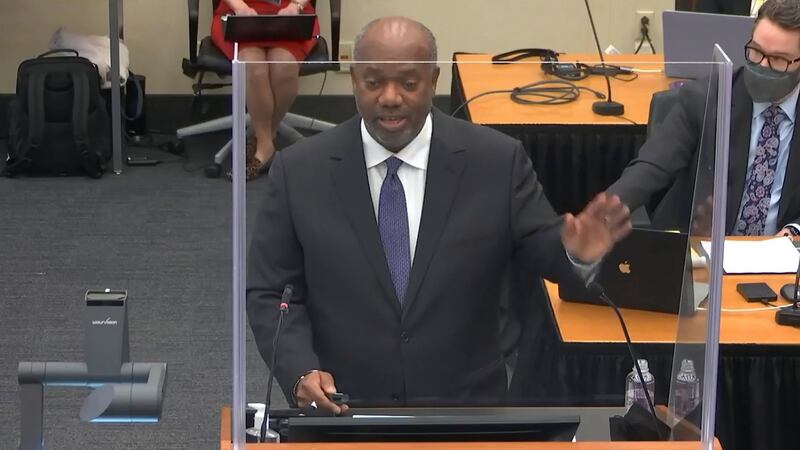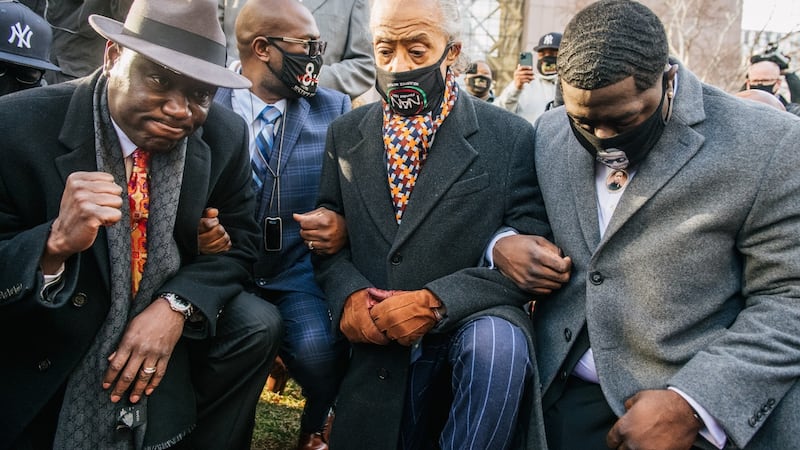Prosecutors in the trial of Derek Chauvin have argued that "excessive and unreasonable force" by the former police officer led to the death of George Floyd last year, as the trial into his death got under way in Minneapolis on Monday.
Mr Floyd died last May as he was being restrained by police. The defendant, Derek Chauvin, was filmed by a passerby pressing his knee on the victim’s neck for almost nine minutes as he stopped breathing. Three other officers were present at the scene.
Mr Floyd’s death sparked global protests and prompted a national conversation in America about race relations and police misconduct.
Lawyers for the prosecution and defence presented their opening arguments and called their first witnesses on Monday. The case is likely to hinge on the cause of death, with the defence team arguing that it was Mr Floyd’s underlying health problems and the presence of drugs such as fentanyl and methamphetamine in his system that killed him.
However, following Mr Floyd’s death the Hennepin County medical examiner classified the death as homicide, citing the cause as “cardiopulmonary arrest complicating law enforcement subdual, restraint and neck compression”.

In his opening statement, lawyer for the prosecution Jerry Blackwell said that the jury would hear evidence during the trial from medical professionals showing that the cause of Mr Floyd's death was asphyxia.
‘Grinding and crushing’
He said images of Mr Chauvin’s actions showed him “grinding and crushing him until the very breath – no, ladies and gentlemen, the very life was squeezed out of him”.
But defence lawyer Eric Nelson said that Mr Chauvin "was doing exactly what he had been trained to do during the course of his 19-year career" when he responded. Lawyers for the defence also focused on the disparity in size between Mr Floyd and the arresting officer. "His size is no excuse," said Mr Blackwell.
The jury of 14 people was shown the video of Mr Floyd’s final minutes by the prosecution.
Among the witnesses who took the stand on the opening day of the trial was Jena Scurry. She was the 911 dispatcher who responded to the initial phone call from a shop assistant alleging that a customer was trying to use a $20 counterfeit note and sent police to the scene. But under questioning by the prosecution on Monday, she described how she became increasingly concerned as she watched the surveillance footage of the arrest in real time.
"My instincts were telling me that something's wrong," she said, stating that she thought the camera had frozen at one point because the restraint was continuing for so long. But the defence team focused their questioning of Ms Scurry on the fact that she is not a trained police officer.
A second witness, 23-year-old Alisha Oyler, who worked at the gas station across from the store where Mr Floyd was arrested, also appeared on the witness stand.
Members of Mr Floyd’s family and civil rights activists have travelled to Minneapolis for the trial, which is expected to last several weeks and is being televised.
Silence
Friends and supporters of Mr Floyd held eight minutes and 46 seconds of silence outside the courtroom on Monday, at 8.46am – symbolising the length of time Mr Chauvin pressed his knee on the victim’s neck.

Speaking outside the courtroom ahead of the trial, civil rights activist and television host Reverend Al Sharpton said that America wanted justice.
"Make no mistake about it, there were videos before and you didn't give us justice," he said, citing footage of previous acts of police violence against Rodney King and Eric Garner.
“You have the opportunity to make it right this time, and make it right for the country. You will never be able to bring this family’s brother back . . . but you can in his name stop this from continuing to happen, over and over again.”











